AUDI TT COUPE 2017 Owners Manual
Manufacturer: AUDI, Model Year: 2017, Model line: TT COUPE, Model: AUDI TT COUPE 2017Pages: 322, PDF Size: 79.73 MB
Page 181 of 322
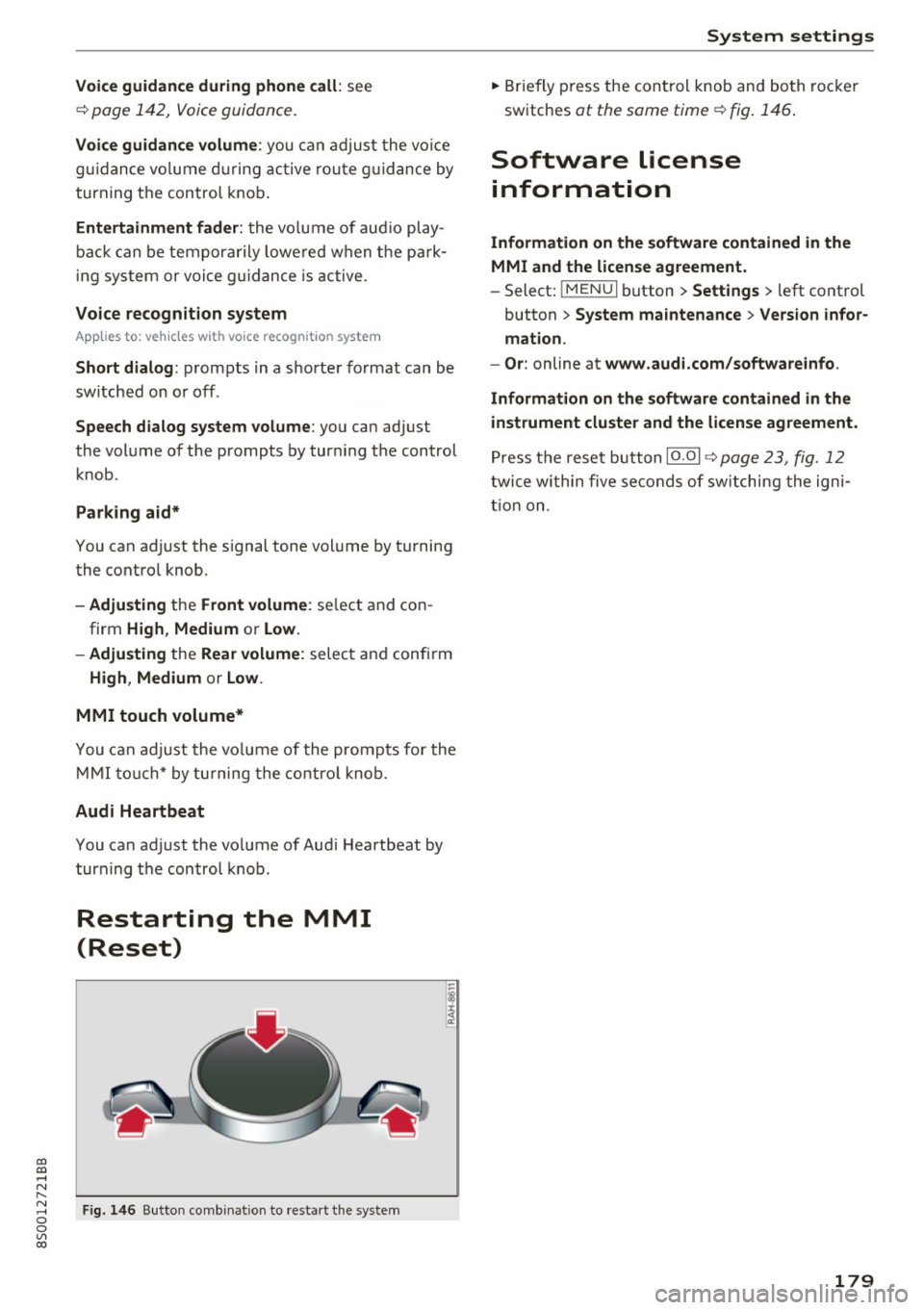
co
co
.... N
" N .... 0
0
Vl c:o
Voice guidance during phone call: see
¢ page 142, Voice guidance.
Voice guidance volume: yo u ca n ad just the v oice
g uid ance vo lume during ac tive rou te gu idance by
turning the control kno b.
Entertainment fader: the vo lume of au dio play
bac k can be tem pora rily lowe re d w hen the p ark
i n g sys tem or voi ce gui dance is ac tive .
Voice recognition system
App lies to: vehicles with voice recognition system
Short dialog : prom pts in a s horte r format can be
switched on o r off .
Speech dialog system volume : you can adj ust
the vol ume of the prompts by tur ning t he control
knob .
Parking aid*
You can adjust th e signal tone vol ume by tu rnin g
the contro l knob .
-Adjusting the Front volume : select and con
firm
High , Medium or Low.
-Adjusting
the Rear volume : select and confirm
High , Medium or Low .
MMI touch volume*
You can a djust the vo lume of the prom pts for the
M MI to uch* by tu rning the con trol kn ob .
Audi Heartbeat
You can ad just the vo lume of Aud i Heartbeat by
turn ing t he control knob.
Restarting the MMI
(Reset)
Fig. 146 B ut to n co mbin at io n t o res tar t t he sys te m
-
I
System settings
.. Brie fly press the con trol knob and bo th roc ke r
sw itches
at the same time ¢ fig. 1 46.
Software license
information
Information on the software contained in the
MMI and the license agreement.
- Select: !ME NUI button> Settings > le ft control
button >
System maintenance > Version infor
mation.
- Or :
online at www.audi.com/softwareinfo .
Information on the software contained in the
instrument cluster and the license agreement.
Pr ess t he rese t button 10 .01 ¢ page 23, fig . 12
twi ce wi thin five se conds of sw itching the ig ni
t io n on .
179
Page 182 of 322
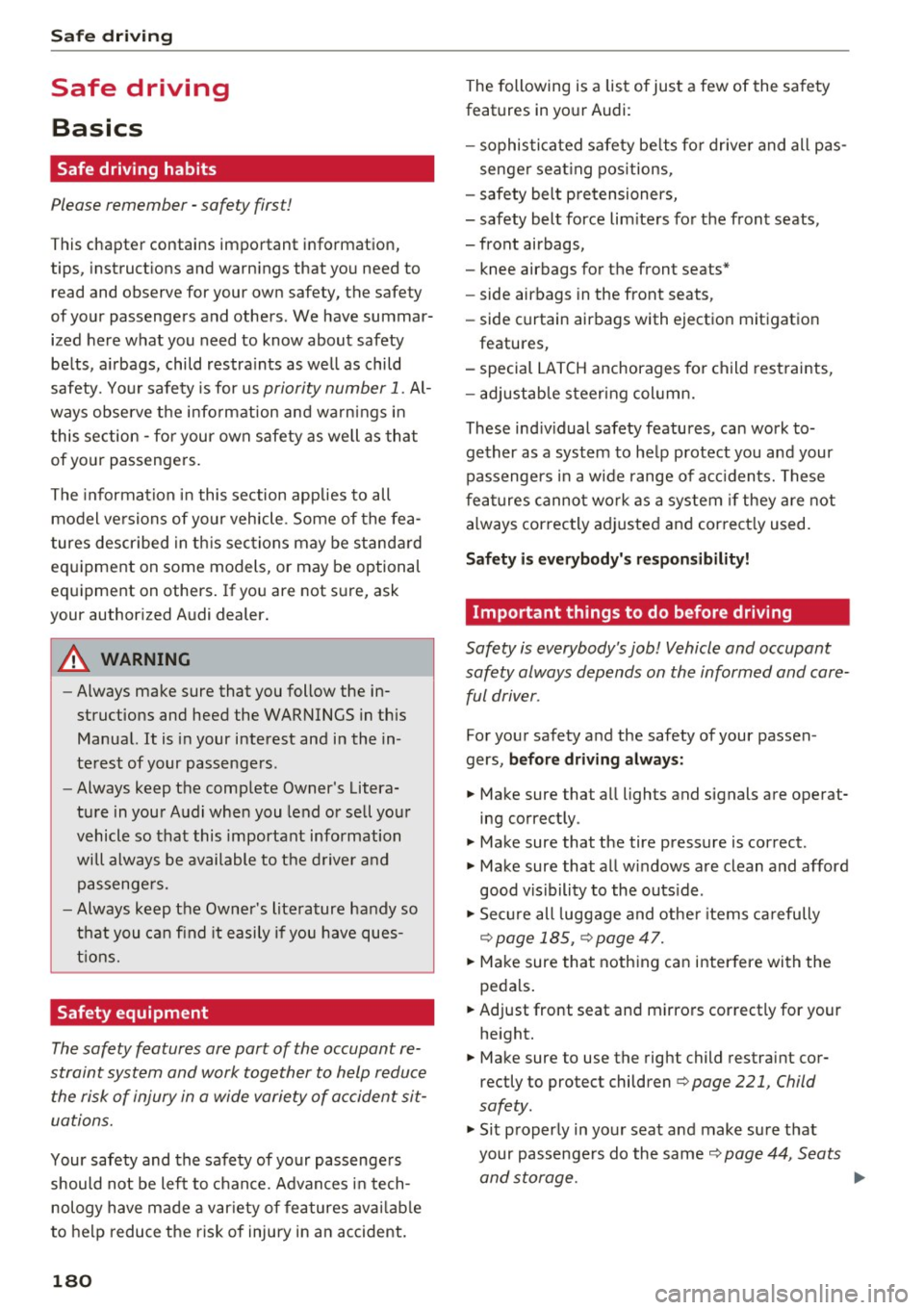
Safe dri ving
Safe driving
Basics
Safe driving habits
Please remember -safe ty first!
This chapter contains important information,
tips, instructions and warnings that you need to
read and observe for your own safety, the safety
of your passengers and others. We have summar ized here what you need to know about safety
be lts, a irbags, child restra ints as well as child
safety. Your safety is for us
priority number 1 . Al
ways observe the info rmation and wa rn ings in
this section - for your own safety as well as that
of your passengers.
The information i n this section applies to all
model versions of yo ur vehicle . Some of the fea
tures descr ibed in t his sections may be s tanda rd
equipment on some models, or may be optional
equipment on others . If you are not sure, ask
your authorized Audi dealer.
A WARNING
- Always make sure that you follow the in
structions and heed the WARNINGS in th is
Manual.
It is in your interest and in the in
te rest of your passengers .
- Always keep the comp lete Owner's Litera
ture in your A udi when you lend or sell your
vehicle so that this important information
will always be available to the d river and
passenge rs.
- Always keep the Owner 's literature handy so
that you can find it easily if you have ques
t ions.
Safety equipment
The safety features are part of the occupant re
straint system and work together to help reduce
the risk of injury in a wide variety of occident si t
uations.
Your safety and the safety of your passenge rs
should not be left to chance. Advan ces i n tech
nology have made a var iety of features avai lab le
to help reduce the risk of injury in an accident .
180
The following is a list of just a few of the safety
features in your Audi :
- sophis tica ted safety be lts fo r drive r and all pas-
senge r seat ing pos itions,
- safety belt p retensioners,
- safety belt force lim ite rs fo r th e front seats,
- front airbags,
- knee airbags fo r the front seats*
- side airbags in the front seats,
- side curtain airbags with eject ion m itigat ion
features,
- special LATCH anchorages for child restraints,
- adj ustab le steering col umn.
These ind iv idual safety features, can work to
gether as a system to he lp protect you and your
passengers i n a wide range of acc idents. These
fea tures canno t wo rk as a sys tem if they a re not
a lways correc tly adjusted and correct ly used.
Safety is everybody' s responsibilit y!
Important things to do before driving
Safety is everybody's job! Vehicle and occupant
safety always depends on the informed and care
ful driver .
For your safety and the safety of your passen
gers,
before driving alway s:
.. Make sure that all lights and signals are operat
ing correctly .
.. Make sure that the tire pressure is correct .
.. Make sure that all windows are clean and afford
good visibility to the outs ide .
.,. Sec ure all luggage and othe r items ca refully
Q page 185, ~page 47.
.,. Make sure that noth ing can inter fere wi th the
peda ls .
.. Ad just front seat and mirrors cor rectly for your
height.
.. Make sure to use the right child restraint cor
rectly to protect children
Q page 221, Child
safety .
.. Sit p roperly in your seat and make sure t hat
your passenge rs do the same
Q page 44, Seats
and storage.
ll-
Page 183 of 322
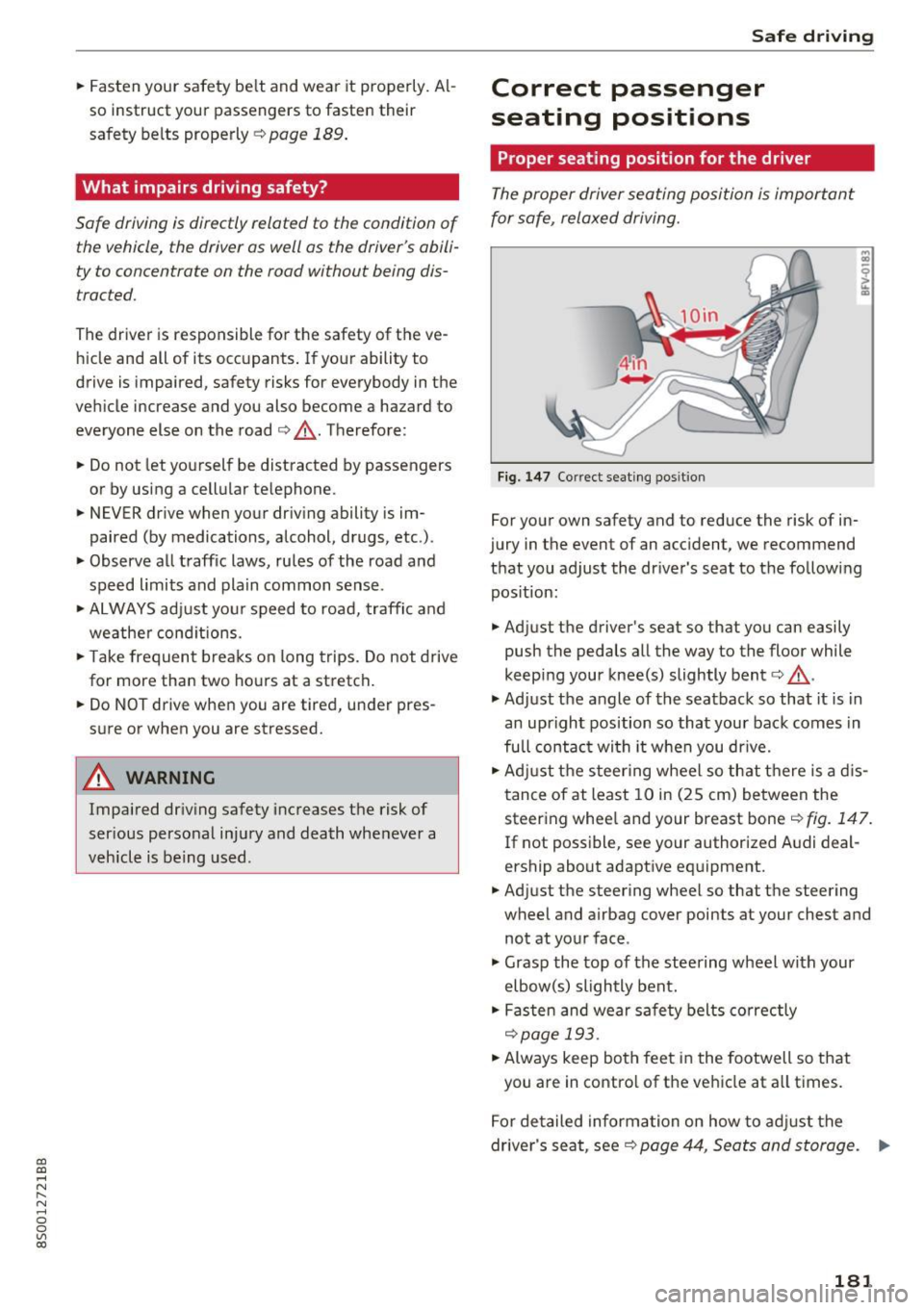
CD
CD
.... N
" N .... 0
0
Ill co
.. Fasten your safety be lt and wear it properly. Al
so instruct your passengers to fasten their
safety belts properly ¢
page 189.
What impairs driving safety?
Safe driving is directly related to the condition of
the vehicle, the driver as well as the driver's abili
ty to concentrate on the road without being dis
tracted.
The driver is responsible for the safety of the ve
hicle and all of its occupants . If your ability to
drive is impaired, safety risks for everybody in the
veh icle increase and you also become a hazard to
everyone else on the road ¢,&. .Therefore:
.. Do not let yourself be distracted by passengers
or by using a cellular te lephone .
.. NEVER drive when your driv ing ability is im
paired (by medications, alcohol, drugs, etc.).
.. Observe a ll traffic laws, rules of the road and
speed limits and plain common sense.
.. ALWAYS adjust your speed to road, traffic and
weather cond itions.
.. Ta ke frequent breaks on long trips. Do not drive
for more than two hours at a stretch .
.. Do NOT drive when you are tired, under pres
sure or when you are stressed.
A WARNING
Impaired driving safety increases the risk of
ser ious personal injury and death whenever a
vehicle is being used.
Safe d riving
Correct passenger
seating positions
Proper seating position for the driver
The proper driver seating position is important
for safe, relaxed driving.
Fig. 147 Correct seating position
For your own safety and to reduce the risk of in
jury in the event of an accident, we recommend
that you adjust the driver's seat to the following position:
.. Adjust the driver's seat so that you can easily
push the pedals all the way to the floor while
keep ing your knee(s) slightly bent¢,&. .
.,. Adjust the angle of the seatback so that it is in
an upright position so that your back comes in
full contact wi th it when you dr ive.
.. Adjust the steering wheel so that there is a dis
tance of at least 10 in (25 cm) between the
steering whee l and your breast bone¢
fig. 147.
If not possible, see your author ized A udi deal
ership about adaptive equipment .
.. Adjust the steering wheel so that the steering
wheel and airbag cover points at your chest and
not at your face .
.,. Grasp the top of the steering wheel with your
elbow(s) slightly bent .
.. Fasten and wear safety belts correctly
¢page 193 .
.. Always keep both feet in the footwell so that
you are in contro l of the vehicle at all times.
For detailed information on how to adjust the
driver's seat, see¢
page 44, Seats and storage. ..,..
181
Page 184 of 322
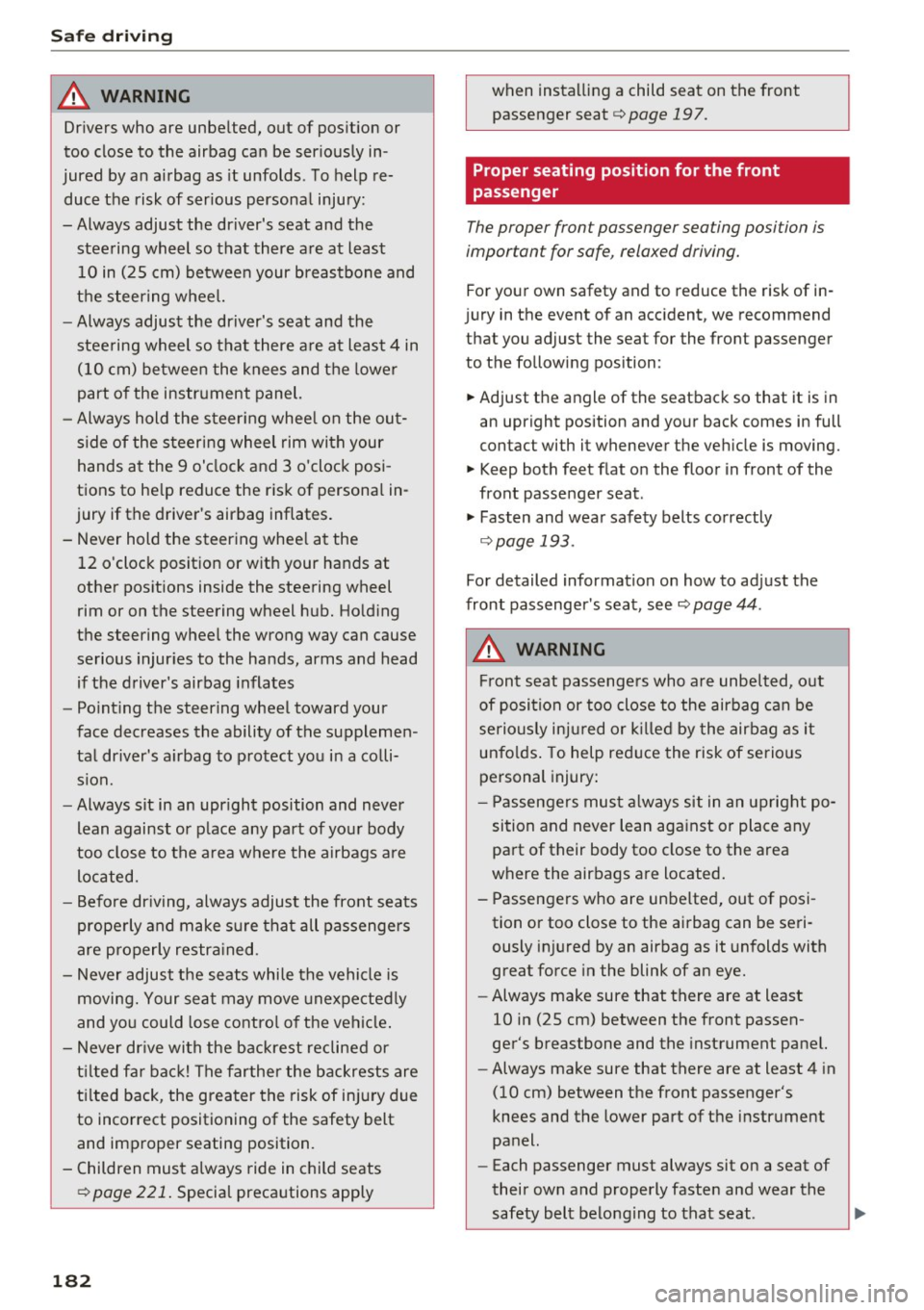
Safe driving
A WARNING
Drivers who are unbelted, out of position or
too close to the airbag can be seriously in
jured by an airbag as it unfolds . To help re
duce the risk of serious personal injury:
- Always adjust the driver's seat and the steering wheel so that there are at least 10 in (25 cm) between your breastbone and
the steering wheel.
- Always adjust the driver's seat and the
steering wheel so that there are at least 4 in
(10 cm) between the knees and the lower
part of the instrument panel.
- Always hold the steering wheel on the out
side of the steering wheel rim with your
hands at the 9 o'clock and 3 o'clock posi
tions to help reduce the risk of personal in
jury if the driver's airbag inflates.
- Never hold the steering wheel at the 12 o'clock position or with your hands at
other positions inside the steering wheel
rim or on the steering wheel hub. Holding
the steering wheel the wrong way can cause
serious injuries to the hands, arms and head if the driver's airbag inflates
- Pointing the steering wheel toward your
face decreases the ability of the supplemen
tal driver's airbag to protect you in a colli
sion.
- Always sit in an upright position and never
lean against or place any part of your body
too close to the area where the airbags are
located.
- Before driving, always adjust the front seats
properly and make sure that all passengers
are properly restrained.
- Never adjust the seats while the vehicle is
moving. Your seat may move unexpectedly
and you could lose control of the vehicle.
- Never drive with the backrest reclined or
tilted far back! The farther the backrests are
tilted back, the greater the risk of injury due
to incorrect positioning of the safety belt
and improper seating position.
- Children must always ride in child seats ¢
page 221. Special precautions apply
182
when installing a child seat on the front passenger seat¢
page 197.
Proper seating position for the front
passenger
The proper fron t passenger sea ting posi tion is
impor tan t for safe , relaxed driving.
For your own safety and to reduce the risk of in
jury in the event of an accident, we recommend
that you adjust the seat for the front passenger
to the following position:
.,. Adjust the angle of the seatback so that it is in
an upright position and your back comes in full
contact with it whenever the vehicle is moving.
.,. Keep both feet flat on the floor in front of the
front passenger seat.
.,. Fasten and wear safety belts correctly
¢ page 193.
For detailed information on how to adjust the
front passenger's seat, see ¢
page 44.
.&, WARNING
Front seat passengers who are unbelted, out
of position or too close to the airbag can be
seriously injured or killed by the airbag as it
unfolds. To help reduce the risk of serious
personal injury:
- Passengers must always sit in an upright po
sition and never lean against or place any
part of their body too close to the area
where the airbags are located.
- Passengers who are unbelted, out of posi tion or too close to the airbag can be seri
ously injured by an airbag
as it unfolds with
great force in the blink of an eye.
- Always make sure that there are at least
10 in (25 cm) between the front passen
ger's breastbone and the instrument panel.
- Always make sure that there are at least 4 in
(10 cm) between the front passenger's
knees and the lower part of the instrument
panel.
- Each passenger must always sit on a seat of
their own and properly fasten and wear the safety belt belonging to that seat .
~
Page 185 of 322
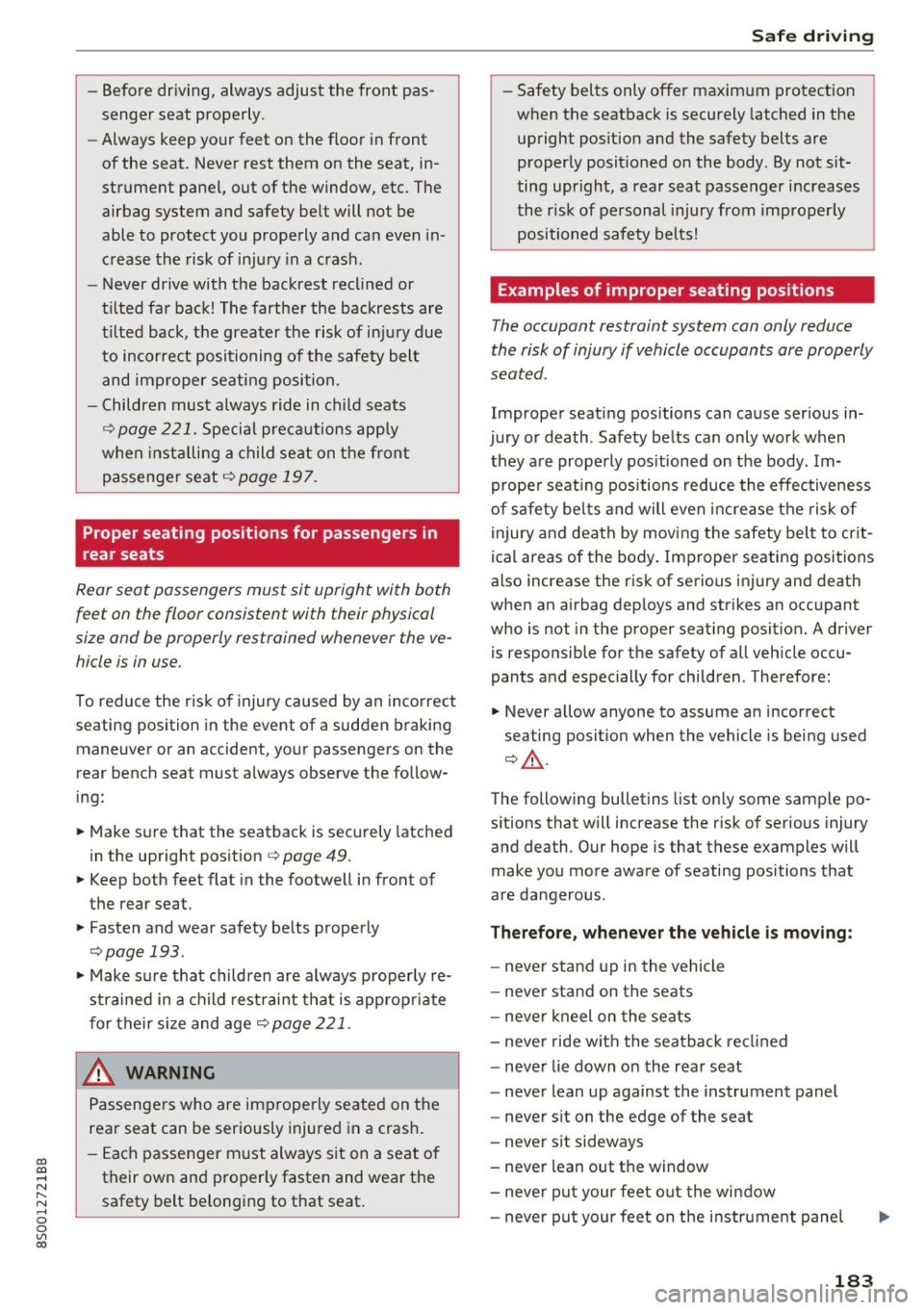
co
co
.... N
" N .... 0
0
Vl c:o
-Before driving, always adjus t the front pas
senger seat properly.
- Always keep your feet on the floor in front
of the seat. Never rest them on the seat, in
strument panel, out of the window, etc. The
airbag system and safety belt will not be
able to protect you properly and can even in
crease the risk of injury in a crash .
- Never drive with the backrest reclined or
t ilted fa r back! The farther the backrests are
t il ted back, the greater the risk of in ju ry due
to incorrect positioning of the safety belt
and improper se ating position.
- Children must a lways ride in child seats
¢ page 221. Special precautions apply
when insta lling a child seat on the front
passenge r seat
¢ page 19 7.
Proper seating positions for passengers in
rear seats
Rear seat passengers must sit upright wi th both
feet on the floor consistent with their physical
size and be properly restrained whenever the ve
hicle is in use.
To reduce the risk o f injury caused by an incorrect
seating position in the event of a sudden braking
maneuver or an accident, yo ur passengers on the
rear bench seat must a lways observe the follow
ing:
• Make s ure that the seatback is sec urely latched
in the upright pos ition
¢ page 49.
• Keep both feet flat in the footwell in front of
the rear seat.
• Fasten and wear safety be lts properly
¢ page 193 .
• Make su re that children are always properly re
st rained in a ch ild res traint that is approp riate
for their size and age
¢ page 221 .
A WARNING
Passengers who are improperly seated on the
rear seat can be seriously injured in a crash .
- Each passenger m ust always sit on a seat of
their own and properly fasten and wear the
safety belt belonging to that seat .
Safe driv ing
- Safety belts only offer maxim um protection
when the seatback is securely latched in the
upright pos ition and the safety belts are
properly posit ioned on the body . By not sit
ting upright, a rear seat passenger increases
the risk of personal injury from improperly
positioned safety belts!
Examples of improper seating positions
The occupant restraint system can only reduce
the risk of injury if vehicle occupants are properly
seated .
Improper seat ing positions can cause ser ious in
jury or death . Safety belts ca n only work when
they a re properly positioned on the body. Im
prope r seat ing positions red uce the effectiveness
of safety be lts an d will even inc rease the risk of
injury and deat h by moving the safety belt to cr it
ical areas of the body. Improper seating posi tions
also increase the risk of se rious i njury and death
when an airbag dep loys and strikes an occ upant
who is not in the proper seating posit ion. A dr iver
is responsible for the safety of all veh icle occu
pants and espec ially for children . Therefore :
• Never allow anyone to assume an incorrect
seating position when the vehicle is being used
¢ .&_ .
The following bulletins list on ly some samp le po
s itions that will increase the r isk of serious injury
and death . Our hope is that these examples will
make yo u more aware of seating positions that
are dangerous .
Therefore, whenever the vehicle is mov ing :
-neve r stand up in the vehicle
- never stand on the seats
- neve r kneel on the seats
- neve r ride wit h the sea tback recl ined
- neve r lie down on the rear seat
- never lean up against the instrument panel
- never s it on the edge of the seat
- neve r sit sideways
- never lean out the window
- neve r put your feet o ut the wi ndow
- neve r put your feet on t he i nstr ument pane l
183
Page 186 of 322
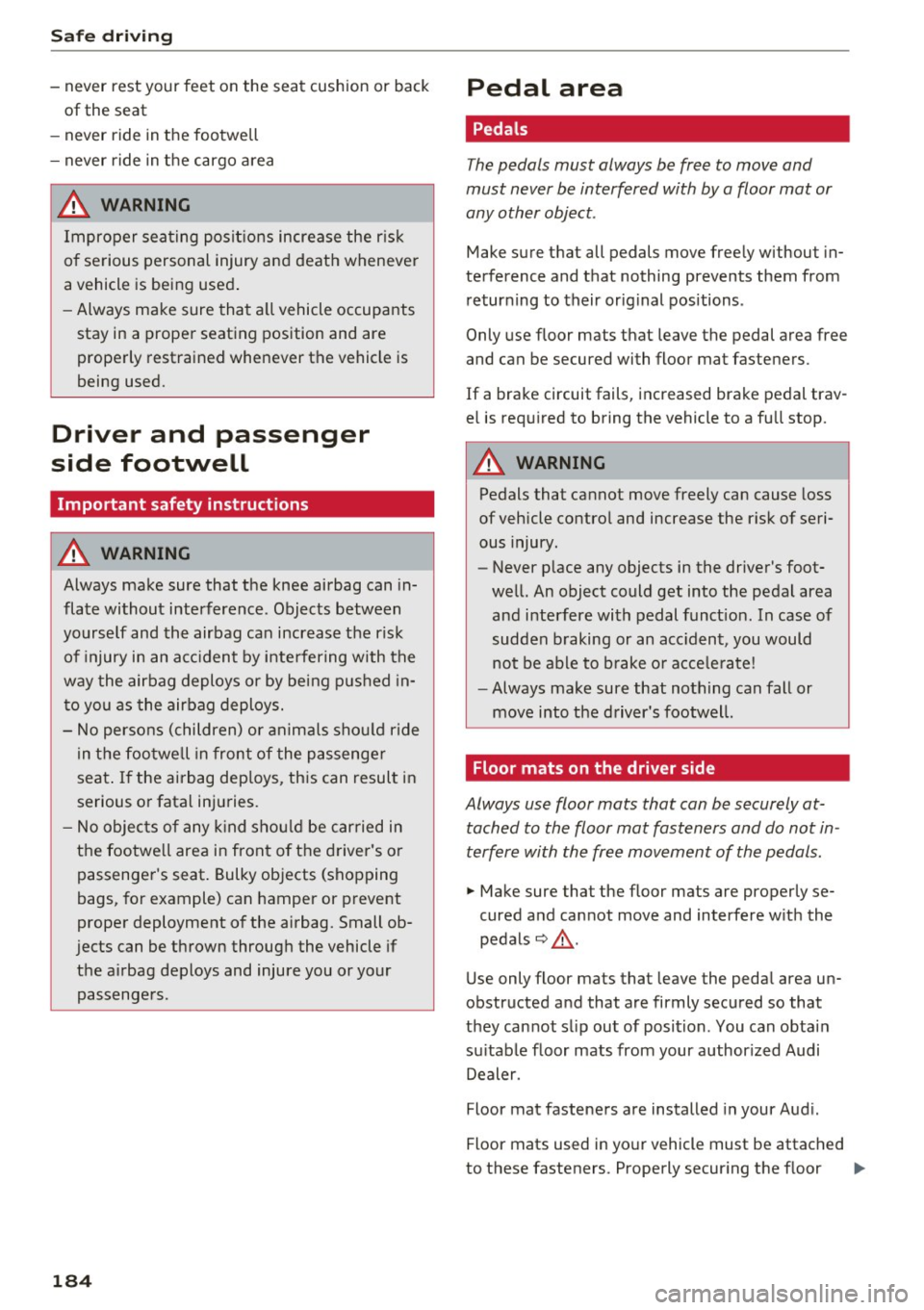
Safe dri ving
- never rest your feet on the seat cushion or back
of the seat
- never ride in the footwell
- never ride in the cargo area
_& WARNING
Improper seating posit ions increase the r isk
of serious personal injury and death whenever
a vehicle is being used .
- Always make sure that all vehicle occupants
stay in a proper seating position and are
properly restrained whenever the vehicle is
being used.
Driver and passenger
side footwell
Important safety instructions
_& WARNING
Always make sure that the knee airbag can in
flate without interference . Objects between
yourself and the airbag can increase the risk
of injury in an acc ident by interfering with the
way the airbag deploys or by being pushed in
to you as the airbag deploys.
- No persons (children) or animals shou ld ride
in the footwell in front of the passenger
seat .
If the airbag dep loys, this can result in
serious or fatal injuries.
- No objects of any kind should be carried in
the footwell area in front of the driver's or
passenger 's seat. Bulky objects (shopping
bags, for example) can hamper or prevent
proper deployment of the airbag. Small ob
jects can be thrown through the vehicle if
the airbag deploys and injure you or your passengers .
184
Pedal area
' Pedals
The pedals must always be free to move and
must never be interfered with by a floor mat or
any other object.
Make sure that all pedals move freely withou t in
terference and that nothing prevents them from
returning to their orig inal positions .
Only use floor mats that leave the pedal area free
and can be secured with floor mat fasteners .
If a brake circuit fails, increased brake pedal trav
el is required to bring the vehicle to a full stop.
_& WARNING
Pedals that cannot move freely can cause loss
of vehicle control and increase the risk of seri
ous injury.
- Never place any objects in the driver's foot
well. An object could get into the pedal area
and interfere with pedal function . In case of
sudden braking or an acc ident, you would
not be able to b rake or acce lerate!
-Always make sure that nothing can fall or
move into the driver's footwell.
Floor mats on the driver side
Always use floor mats that can be securely at tached to the floor mat fasteners and do not in
terfere with the free movement of the pedals.
.. Make sure that the floor mats are properly se
cured and cannot move and interfere with the
pedals
~ .,&.. .
Use only floor mats that leave the pedal area un
obstructed and that are firmly secured so that
they cannot slip out of position . You can obta in
su itable floor mats from your author ized Audi
Dealer.
Floor mat fasteners are installed in your Audi.
Floor mats used in your vehicle must be attached
to these fasteners . Properly securing the f loor
IJI>
Page 187 of 322
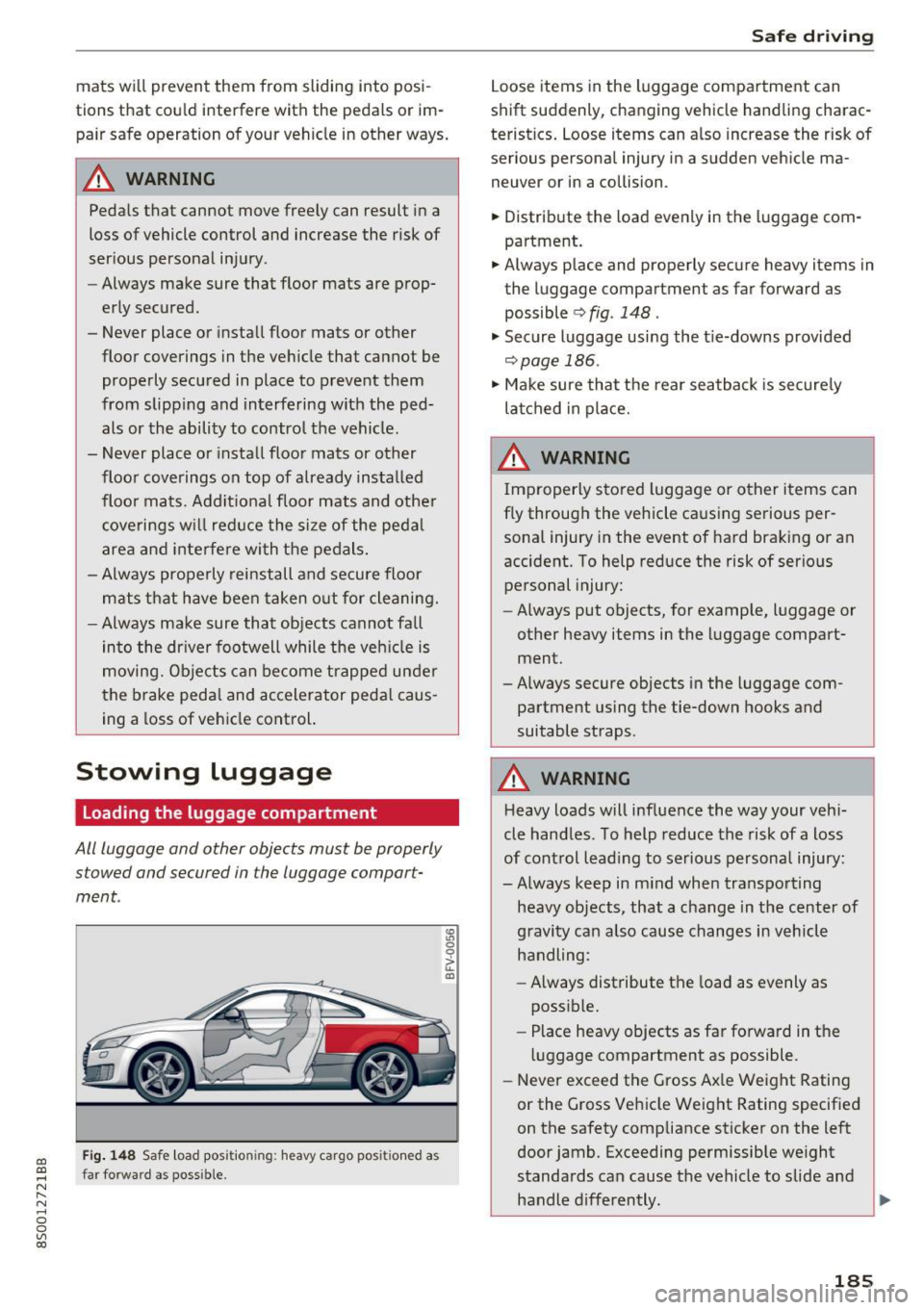
CD
CD
.... N
" N .... 0
0
Ill co
mats will prevent them from sliding into posi
tions that could interfere with the pedals or im pa ir safe operation of your vehicle in other ways.
.&_ WARNING
Pedals that cannot move freely can result in a
loss of vehicle control and increase the risk of
serious personal injury .
- Always make sure that floor mats are prop
erly secured.
- Never place or install floor mats or other floor coverings in the veh icle that cannot be
properly secured in place to prevent them
from slipp ing and interfering with the ped
als or the ability to contro l the vehicle.
- Never place o r install floor mats or other
floor coverings on top of already installed
floo r mats. Add it ional floor mats and othe r
coverings w ill reduce the size of the peda l
area and interfere with the pedals.
- Always properly reinstall and secure floor
mats that have bee n taken o ut for cleaning.
- Always make sure that objects cannot fall
in to the dr iver footwell while the veh icle is
moving. Objects can be come trapped under
the brake peda l and accelerator pedal caus
ing a loss of vehicle control.
Stowing luggage
Loading the luggage compartment
All luggage and other objects must be properly
stowed and secured in the luggage compart
ment.
Fig . 14 8 Safe load pos itio ning: heavy cargo posi tioned a s
far forward as poss ib le .
~ 0 0
ii: ID
Saf e drivi ng
Loose items in the luggage compartment can
shift suddenly, changing vehicle handling charac
teristics . Loose items can also increase the risk of
serious personal injury in a sudden veh icle ma
neuver or in a collision .
.,. Distribute the load evenly in the luggage com
partment.
.,. Always place and properly secure heavy items in
the luggage compartment as far forward as possible
¢ fig. 148 .
"' Secure luggage using the t ie-downs provided
¢ page 186.
"' Make sure that the rear seatback is secure ly
la tched in p lace.
.&_ WARNING
Imp roper ly stored luggage or other i tems can
f ly through the vehicle causing serious per
sonal injury in the event of hard braking or an
accident. To help reduce the risk of serio us
personal injury:
- Always put objects, for example, luggage or
other heavy items in the luggage compart
ment.
-Always secure objects in the luggage com
partment using the tie-down hooks and
suitable straps .
.&_ WARNING
-
Heavy loads will influence the way your vehi
cle handles . To help reduce the risk of a loss
of cont rol lead ing to serious personal injury:
-Always keep in m ind when transpo rting
heavy objects, that a change in the center of
gravity can also cause changes in vehicle
handling :
- Always distribute the load as evenly as
poss ible.
- Place heavy objects as far forward in the
luggage compartment as possible.
- Never exceed the Gross Ax le Weight Rating
or the G ross Vehicle Weight Rating specif ied
on the safety compliance sticker on the left
door jamb. Exceeding permissible we ight
standards can cause the vehicle to slide and handle differently.
~
185
Page 188 of 322
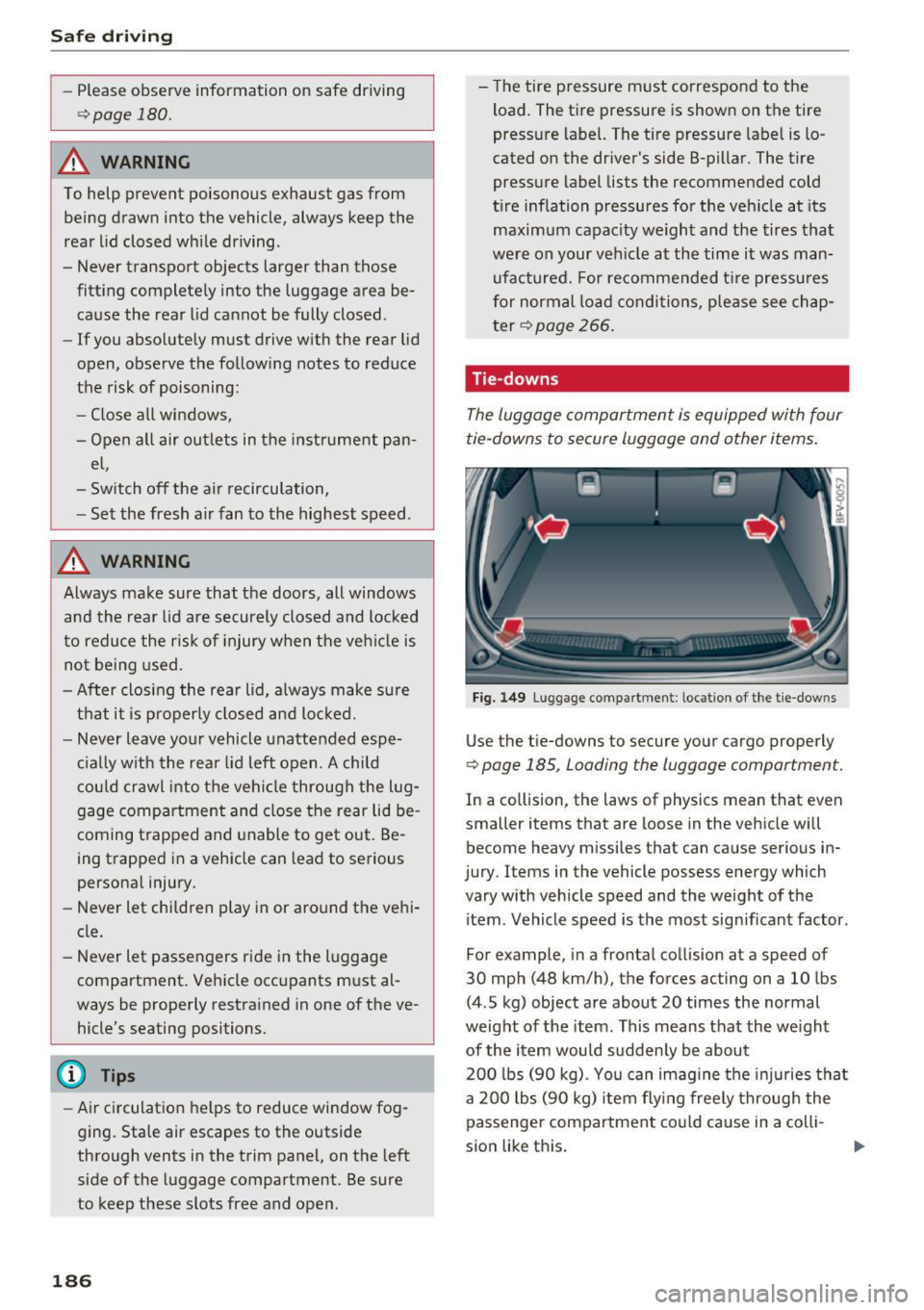
Safe dri ving
- Please observe information on safe driving
c>page 180.
A WARNING
To help prevent poisonous exhaust gas from
being drawn into the vehicle, always keep the
rear lid closed whi le driving.
- Never transport objects larger than those
fitting completely into the luggage area be cause the rear lid cannot be fully closed .
- If you absolutely must drive with the rear lid
open, observe the following notes to reduce
the risk of poisoning:
- Close al l w indows,
- Open all air outlets in the instrument pan-
el,
- Switch off the air recirculation,
- Set the fresh air fan to the highest speed.
A WARNING
Always make sure that the doors, all windows
and the rear lid are securely closed and locked
t o reduce the ris k of injury when the vehicle is
not be ing used.
- After closing the rear lid, always make su re
that it is properly closed and locked.
- Never leave yo ur vehicle unattended espe
cially with the rear lid left open. A chi ld
could crawl into the vehicle through the lug
gage compartment and close the rear lid be
coming trapped and unable to get out. Be
ing trapped in a vehicle can lead to serious
persona l injury.
- Never let children play in or around the ve hi
cle .
- Never let passengers ride in the luggage
compartment. Veh icle occupants must al
ways be properly restrained in one of the ve
hicle's seating positions.
@ Tips
- Air circulation helps to reduce window fog
ging. Stale air escapes to the outside
through vents in the trim panel, on the left
side of the luggage compartment. Be sure
to keep these slots free and open.
186
- Th e tire pressure must correspond to the
load. The tire pressure is shown on the tire
pressure label. The tire pressure label is lo
cated on the driver's side B-pillar. The tire
pressure label lists the recommended cold
tire inf lation pressures for the vehicle at its
maximum capac ity we ight and the tires that
were on your vehicle at the time it was man
ufactured. For recomme nded t ire pressures
for normal load condi tions, please see chap
ter
c> page 266.
Tie-downs
The luggage compartment is equipped with four
tie -downs to secure luggage and other items.
Fig. 149 Luggage compartment : location of the tie- downs
Use the tie-downs to secure your cargo properly
c> page 185, Loading the luggage compartment.
In a co llision , the laws of physics mean that even
smaller items that are loose in the vehicle will
become heavy missiles that can cause serious in
jury . Items in the vehicle possess energy which
vary with vehicle speed and the weight of the i tem . Vehicle speed is the most significant factor.
For example, in a frontal collision at a speed of
30 mph (48 km/h), the forces acting on a 10 lbs
(4 .5 kg) object are about
20 times the normal
weight of the item. This means that the weight
of the item would sudden ly be about
200 lbs (90 kg) . You can imag ine the injuries that
a
200 lbs (90 kg) item flying freely through the
passenger compartment could cause in a colli
sion like th is .
Page 189 of 322
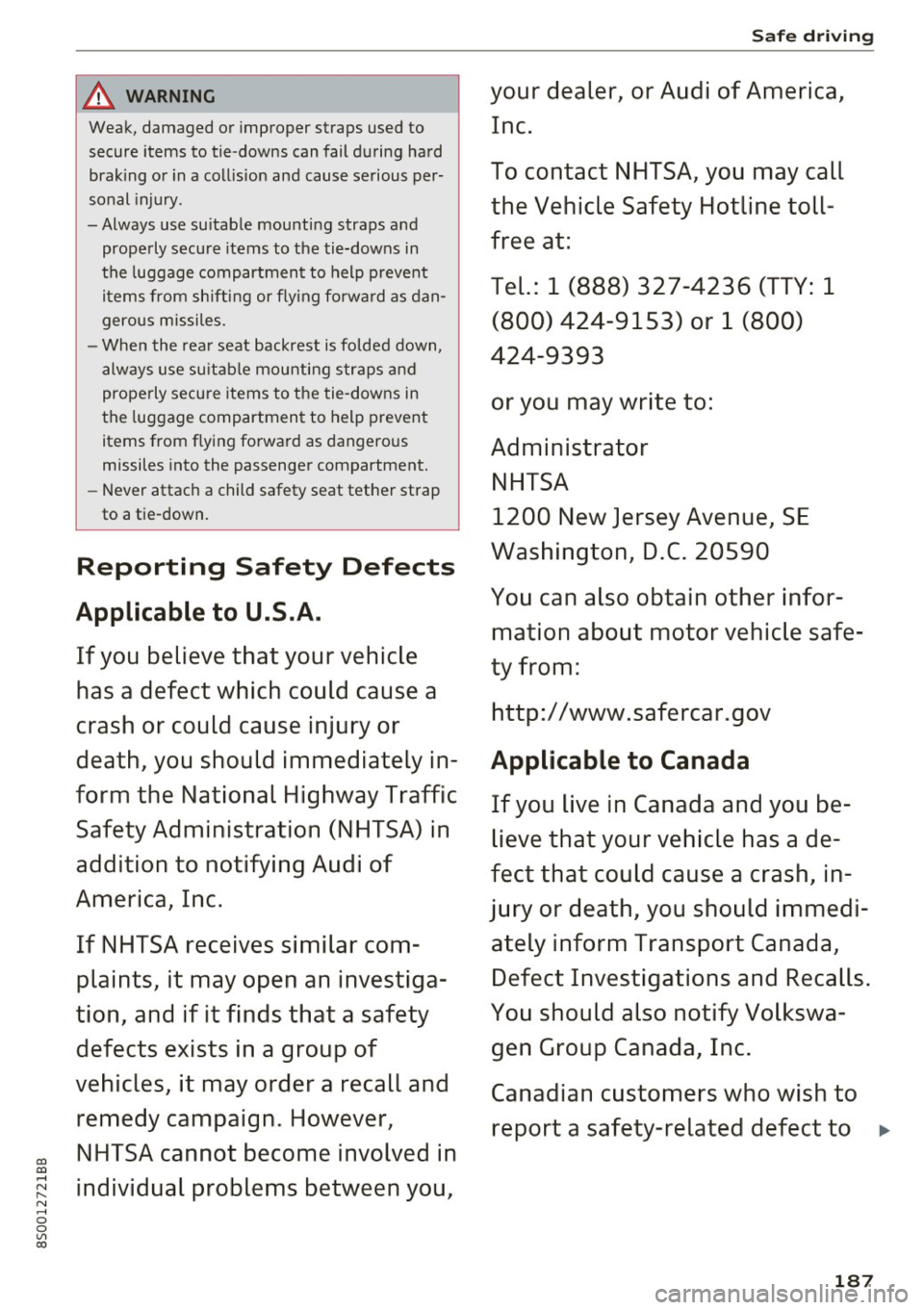
co
co
Safe driving
A WARNING your dealer, or Audi of America,
,~ -
Weak, damaged or improper straps used to Inc.
secure items to tie -downs can fail during hard
braking or in a collision and cause serious per
sonal injury.
-Always use suitable mounting straps and properly secure items to the tie-downs in
the luggage compartment to help prevent
items from shifting or flying forward as dan
gerous missiles .
- When the rear seat backrest is folded down,
always use suitable mounting straps and
properly secure items to the tie-downs in
the luggage compartment to help prevent
items from flying forward as dangerous
missiles into the passenger compartment.
- Never attach a child safety seat tether strap
to a tie-down.
Reporting Safety Defects
Applicable to U.S.A.
If you believe that your vehicle
has a defect which could cause a
crash or could cause injury or
death, you should immediately in
form the National Highway Traffic Safety Administration (NHTSA) in
addition to notifying Audi of
America, Inc.
If NHTSA receives similar com
plaints, it may open an investiga
tion, and if it finds that a safety
defects exists in a group of
vehicles, it may order a recall and remedy campaign. However, NHTSA cannot become involved in To contact NHTSA, you may call
the Vehicle Safety Hotline toll
free at:
Tel.: 1 (888) 327-4236 (TTY: 1
(800) 424-9153) or 1 (800)
424-9393
or you may write to:
Administrator NHTSA 1200 New Jersey Avenue, SE
Washington, D.C. 20590
You can also obtain other infor
mation about motor vehicle safe
ty from:
http:/ /www.safercar.gov
Applicable to Canada
If you live in Canada and you be
lieve that your vehicle has a de-
fect that could cause a crash, in
jury or death, you should immedi ately inform Transport Canada, Defect Investigations and Recalls.
You should also notify Volkswa- gen Group Canada, Inc.
Canadian customers who wish to
report a safety-related defect to ..,.
~ individual problems between you, N ...... 0
0
Vl c:o
187
Page 190 of 322
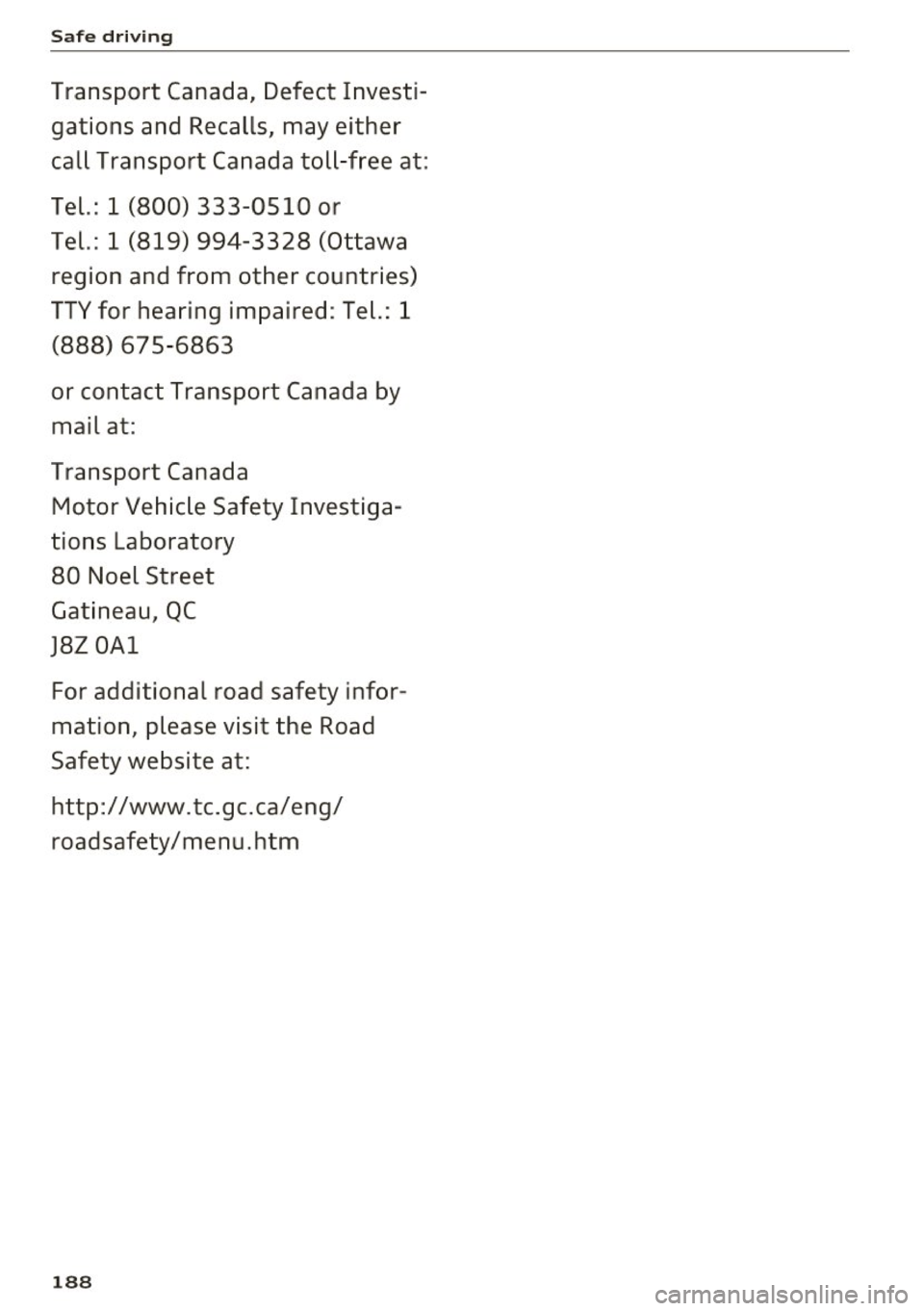
Safe driving
Transport Canada, Defect Investi
gations and Recalls, may either
call Transport Canada toll-free at :
Tel. : 1 (800) 333-0510 or
Tel.: 1 (819) 994-3328 (Ottawa
region and from other countries)
TTY for hearing impaired: Tel.: 1
(888) 675-6863
or contact Transport Canada by mail at:
Transport Canada Motor Vehicle Safety Investiga
tions Laboratory
80 Noel Street
Gatineau, QC
J8Z OAl
For additional road safety infor
mation, please visit the Road
Safety website at:
http:/ /www.tc.gc.ca/eng/ roadsafety/menu.htm
188